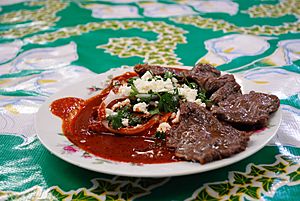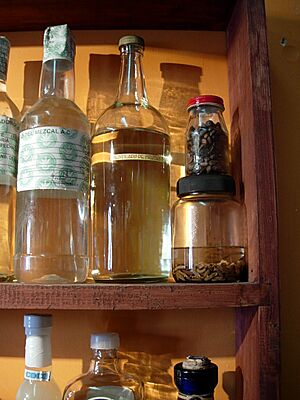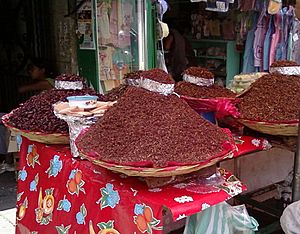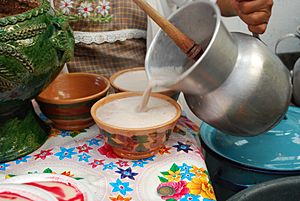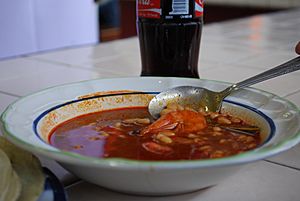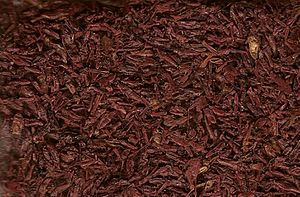Oaxacan cuisine facts for kids
Oaxacan cuisine is the special food from the city of Oaxaca in southern Mexico. Oaxaca is famous around the world for its delicious food. Like most Mexican food, Oaxacan dishes use main ingredients such as corn, beans, and chili peppers. But there are many other ingredients and ways of cooking because of Oaxaca's different landscapes and native cultures. Corn and many types of beans were first grown here!
Some well-known parts of Oaxacan food include chocolate (often drunk hot with spices), Oaxaca cheese, mezcal (a special drink), and grasshoppers (chapulines). Famous dishes are tlayudas, Oaxacan style tamales, and seven special kinds of mole sauce. Food experts like Diana Kennedy and Rick Bayless have praised this food. It helps make Oaxaca a popular place for tourists to visit.
Contents
What Makes Oaxacan Food Special?
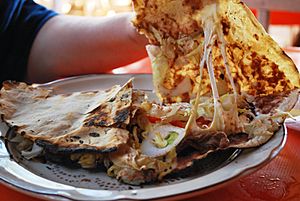
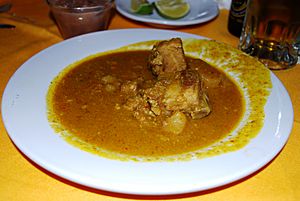
Oaxaca has many mountains, which means it has different climates and cultures. This helps make its food the most varied in Mexico. The state has coastal areas with seafood. The Central Valley grows many vegetables. Areas near Veracruz provide tropical fruits all year. Oaxaca also has seventeen different native groups, and each adds its own cooking traditions. For example, the Trique people are known for their pit barbecuing. Even though Oaxaca has amazing food, some people still find it hard to get enough to eat.
Corn is the main food in Oaxaca. Mexicans have used corn for over 7,000 years! Corn is usually dried and ground into a dough. This dough is used for dishes like entomatadas, empanadas, and tamales. Thin corn tortillas are called blandas and are eaten with almost every meal.
The main flavor comes from chili peppers. Some types are amarillos, chilhuacles, and costeños. But the most unique is the pasilla oaxaqueña chili. Special herbs include hoja santa, often used in chicken, pork, and fish dishes, and epazote. A local herb called “pitonia” is also used.
Two famous parts of Oaxacan food are drinking chocolate and eating insects, especially grasshoppers called chapulines. Less common local foods include rose petal ice cream and squash flowers. Squash flowers are found in empanadas, quesadillas, and soups.
For beans, Oaxacan cooking often uses black beans. They are cooked with aniseed and served as soup, on street food, or with scrambled eggs.
Another special ingredient is Oaxaca cheese, also called quesillo. It is used to make empanadas, tortas, and tlayudas.
Oaxacan cooking changes from one region to another. But some dishes are found almost everywhere. Tlayudas are large, chewy tortillas with toppings like beans, guacamole, meat or seafood, and cheese. The most traditional Oaxacan tamales are big. They are wrapped in banana leaves and filled with mole. Other tamale types include yellow (amarillo), green (verde), and sweet (dulce). In the Isthmus of Tehuantepec, some tamales have iguana meat. Along the coast, they can have seafood.
Oaxaca is famous for its chocolate. It is traditionally ground by hand and mixed with almonds, cinnamon, and other things. It is usually drunk as a hot drink. Other typical drinks include mezcal, different kinds of atole, champurrado, and various fruit drinks.
Food from the Central Valleys
The main food center of Oaxaca is its capital city, also called Oaxaca. This city is in the Central Valleys region. The Zapotecs have been the main native group here for a long time. But other groups, like the Mixtecs, have also influenced the food. Native people in Oaxaca have grown corn, beans, squash, and other crops for thousands of years. In villages, especially native ones, families still rely on these foods. They are grown mostly on small farms, with few changes over time.
The cooking here still has much of its native flavor. For example, some dishes are made without fat, which was not known before the Spanish arrived. They also use many vegetables and herbs from the valley, especially in their moles. However, since it is the state capital, it also has influences from other parts of Oaxaca.
The best place to find mezcal is in this area. It is between Oaxaca city and Mitla. Like tequila, mezcal is made from the cooked heart of the maguey or agave plant. But its flavor is very different. People describe it as smoky, and it is usually drunk plain. It comes in different types and can have flavors like almond, coffee, or orange. A related traditional drink is aguamiel. This is the non-alcoholic sap from the maguey plant.
You can experience much of this area's food in its many markets. You will find a wide variety of ingredients for sale. You can also buy ready-to-eat foods. All markets have areas with food stands. One of the most famous is the 20 de Noviembre market. It is full of food stands that make everything from different moles to hot chocolate with pan de yema bread. It also has a section for meats like tasajo and chorizo. These are cooked when you order them and eaten with large corn tortillas, guacamole, and grilled vegetables.
The Central Valley is a bit far away, but it is one of Mexico's food capitals. Food experts like Alice Waters and Rick Bayless have praised its food. This has helped tourism in the area. People come to try the food. One event getting more attention is the “Food of the Gods Festival” in the capital city. Besides food tastings, there are cooking classes taught by local chefs. You can also try wine and mezcal, learn to make chocolate, and visit coffee farms. Many professional chefs now work in the city of Oaxaca. These chefs run fancy restaurants like La Biznaga. They mix Oaxacan cooking with modern styles. They also get all their ingredients from local markets and farms.
Oaxacan Chocolate

Oaxaca produces and sells a lot of coffee. But chocolate is an even more important drink. Oaxaca is one of the Mexican states that grows cacao. Cacao and chocolate have been used in Oaxaca as food, drink, and medicine. In the past, cacao beans were even used as money!
In the center of Oaxaca city, many businesses grind and prepare cacao. They use it for hot chocolate drinks, moles, and more. The most famous of these businesses is El Mayordomo. Inside, their big machines grind cacao beans. These beans are then mixed with sugar and other flavors like almonds and cinnamon. Most of the cacao is made for drinking.
Hot chocolate is made by mixing the chocolate with water or milk. It is heated in a pot. Before serving, a special tool is used to make a foam on top. This tool is twirled quickly by rubbing its handles between your hands. The foamy cacao drink is called Pozonque.
Most chocolate is drunk hot. But it is also a key ingredient in a cold drink called tejate. It is made with fermented corn, cacao, and the seed of the mamey fruit. It is traditionally served in dried and painted gourd bowls. Tejate is usually found in towns just outside Oaxaca city. It used to be considered a full meal. However, tejate is becoming less common and harder to find.
The Seven Famous Moles
Oaxaca has over 200 known ways to make mole. Mole is a complex sauce made from one or more chili peppers. However, seven moles are the most famous. This gives Oaxaca the nickname “land of the seven moles.” Oaxacan moles need many ingredients and a long cooking time. Because of this, they are usually served only for special events.
Ingredients for moles were traditionally ground on a metate (a special grinding stone). Today, blenders and food mills are often used to grind and mix the ingredients. Depending on the ingredients, they are toasted or fried. Then they are mixed with others to make a sauce that is slowly cooked. Recipes can be different from one cook to another. Chocolate is used in two of the seven moles, but it is not the most important ingredient. Oaxacan moles are served with chicken, pork, and beef. However, the sauce is more important in a mole dish than the meat.
The name, color, and ingredients tell the seven main moles apart. They are called negro (black), amarillo (yellow), coloradito (little red), mancha manteles (tablecloth stainer), chichilo (named after a pepper), rojo (red), and verde (green). All moles, except verde, can be kept as a paste. Later, they can be cooked by adding chicken broth.
- Mole negro is the most famous and complex mole. It can have twenty to over thirty ingredients! It is slightly sweet and black. It uses six different types of chili peppers, plantains, onion, tomatoes, tomatillos, cloves, cinnamon, chocolate, nuts, tortillas, and avocado leaves. To get the black color, the chili peppers must be well toasted but not burned.
- Mole amarillo contains green tomatoes, onion, garlic, cumin, cloves, ancho chili peppers, guajillo chili peppers, and hoja santa or cilantro. It is served with onions, lime, and oregano.
- Mole coloradito is brick red. It has ancho chili peppers, tomatoes, garlic, sesame seeds, almonds, cinnamon, and oregano.
- Mancha manteles is red. It uses ancho chili peppers, tomatoes, garlic, onion, thyme, cloves, and almonds.
- Another red mole is chichilo. It uses chihuacle, negro, pasilla, and mulato chili peppers, tomatoes, marjoram, allspice, cloves, and avocado leaves.
- Rojo is red, as its name suggests. Ingredients include chocolate, guajillo chili peppers, onion, tomatoes, garlic, oregano, nuts, and sesame seeds.
- Mole verde contains tomatillos, green chili peppers, onion, garlic, cumin, cloves, ancho and guajillo chili peppers, hoja santa, epazote, and parsley. It has a light, herby taste. Of all the sauces, verde is the easiest to make. It does not need chili peppers to be toasted and rehydrated.
Chapulines: Edible Grasshoppers
People in Oaxaca eat different insects. These include ants and grubs from maguey plants. But the most famous are grasshoppers, called chapulines. Even though they are eaten in other parts of Mexico, chapulines are most popular in the Central Valleys area of Oaxaca. They are a good source of protein in rural areas. In Oaxaca city, they are a special treat. People have eaten them since long before the Spanish arrived. They are usually eaten as a seasoning, a snack, or sometimes as the main dish. Collecting and selling them is a full-time job for many people. It is an important way for many rural families to earn money. They are even sent to the United States!
The grasshoppers that are eaten are collected from corn and alfalfa fields. They are semi-domesticated. This means they live longer and have more babies than wild grasshoppers. The time to harvest these insects is during the rainy season, from late spring to early winter. This season starts when new grasshoppers, called nymphs, hatch. These young ones taste sweet and cost more. Older grasshoppers tend to taste a little bitter.
Clean grasshoppers are cooked by putting them in boiling water. This water is flavored with garlic and lime. The most common way to eat them is fresh off a comal (a flat griddle) with a tortilla. But they are also eaten fried with chili powder as a snack (especially with mezcal). You can also find them in more fancy dishes, in a sauce, or mixed with eggs.
See also
 In Spanish: Gastronomía de Oaxaca para niños
In Spanish: Gastronomía de Oaxaca para niños



